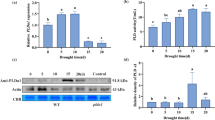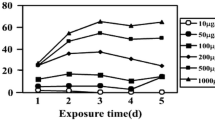Abstract
The xanthophyll cycle and the water-water cycle had different functional significance in chilling-sensitive sweet pepper upon exposure to chilling temperature (4 °C) under low irradiance (100 µmol m−2 s−1) for 6 h. During chilling stress, effects of non-photochemical quenching (NPQ) on photosystem 2 (PS2) in dithiothreitol (DTT) fed leaves remained distinguishable from that of the water-water cycle in diethyldithiocarbamate (DDTC) fed leaves. In DTT-fed leaves, NPQ decreased greatly accompanied by visible inhibition of the de-epoxidized ratio of the xanthophyll cycle, and maximum photochemical efficiency of PS2 (Fv/Fm) decreased markedly. Thus the xanthophyll cycle-dependent NPQ could protect PS2 through energy dissipation under chilling stress. However, NPQ had a slighter effect on photosystem 1 (PS1) in DTT-fed leaves than in DDTC-fed leaves, whereas effects of the water-water cycle on PS1 remained distinguishable from that of NPQ. Inhibiting superoxide dismutase (SOD) activity increased the accumulation of \(\operatorname{O} \overline {^-- } _2\), the oxidation level of P700 (P700+) decreased markedly relative to the control and DTT-fed leaves. Both Fv/Fm and NPQ changed little in DDTC-fed leaves accompanied by little change of (A+Z)/(V+A+Z). This is the active oxygen species inducing PS1 photoinhibition in sweet pepper. The water-water cycle can be interrupted easily at chilling temperature. We propose that during chilling stress under low irradiance, the xanthophyll cycle-dependent NPQ has the main function to protect PS2, whereas the water-water cycle is not only the pathway to dissipate energy but also the dominant factor causing PS1 chilling-sensitivity in sweet pepper.
Similar content being viewed by others
Abbreviations
- A:
-
antheraxanthin
- DDTC:
-
diethyldithiocarbamate
- DTT:
-
dithiothreitol
- Fm :
-
maximum yield of fluorescence after dark adaptation
- Fm‘:
-
maximum yield of fluorescence in light-acclimated leaves
- F0 :
-
initial fluorescence
- Fv/Fm :
-
maximum photochemical efficiency of PS2 with all reaction centres open
- FM:
-
fresh mass
- NPQ:
-
non-photochemical quenching
- P700:
-
reaction centre chlorophyll of PS1
- PFD:
-
photon flux density
- PS1:
-
photosystem 1
- PS2:
-
photosystem 2
- SOD:
-
superoxide dismutase (EC 1.15.1.1)
- V:
-
violaxanthin
- Z:
-
zeaxanthin
References
Asada, K.: The water-water cycle in chloroplasts: Scavenging of active oxygen and dissipation of excess photons. — Annu. Rev. Plant Physiol. Plant mol. Biol. 50: 601–639, 1999.
Demmig-Adams, B., Adams, W.W., III: The role of xanthophyll cycle carotenoids in the protection of photosynthesis. — Trends Plant Sci. 1: 21–26, 1996.
Endo, T., Shikanai, T., Takabayashi, A., Asada, K., Sato, F.: The role of chloroplastic NAD(P)H dehydrogenase in photoprotection. — FEBS Lett. 457: 5–8, 1999.
Giannopolitis, C.N., Ries, S.K.: Superoxide dismutases. I. Occurrence in higher plants. — Plant Physiol. 59: 309–314, 1977.
Horton, P., Ruban, A., Walters, R.G.: Regulation of light harvesting in green plants. Indication by nonphotochemical quenching of chlorophyll fluorescence. — Physiol. Plant. 106: 415–420, 1994.
Huner, N.P.A., Oquist, G., Sarhan, F.: Energy balance and acclimation to light and cold. — Trends Plant Sci. 3: 224–230, 1998.
Jakob, B., Heber, U.: Photoproduction and detoxification of hydroxyl radicals in chloroplasts and leaves and relation to photoinactivation of photosystem I and II. — Plant Cell Physiol. 37: 629–635, 1996.
Krause, G.H.: Photoinhibition induced by low temperatures. — In: Baker, N.R., Bowyer, J.R. (ed.): Photoinhibition of Photosynthesis: From Molecular Mechanisms to the Field. Pp. 331–348. Bios Scientific Publ., Oxford 1994.
Li, X.G., Duan, W., Meng, Q.W., Zou, Q., Zhao, S.J.: The function of chloroplastic NAD(P)H dehydrogenase in tobacco during chilling stress under low irradiance. — Plant Cell Physiol. 45: 103–108, 2004a.
Li, X.-G., Meng, Q.-W., Jiang, G.-Q., Zou, Q.: The susceptibility of cucumber and sweet pepper to chilling under low irradiance is related to energy dissipation and water-water cycle. — Photosynthetica 41: 259–265, 2003.
Li, X.-G., Wang, X.-M., Meng, Q.-W., Zou, Q.: Factors limiting photosynthetic recovery in sweet pepper leaves after shortterm chilling stress under low irradiance. — Photosynthetica 42: 257–262, 2004b.
Liu, P., Meng, Q.W., Zou, Q., Zhao, S., Liu, Q.: Effects of coldhardening on chilling-induced photoinhibition of photosynthesis and on xanthophyll cycle pigments in sweet pepper. — Photosynthetica 39: 467–472, 2001.
Miszalski, Z.: Influence of DDTC on SO2 effect on tomato seedling (Lycopersicon esculentum Mill.) photosynthesis. — Environ. exp. Bot. 31: 125–130, 1991.
Muller, P., Li, X.P., Niyogi, K.K.: Non-photochemical quenching. A response to excess light energy. — Plant Physiol. 125: 1558–1566, 2001.
Powles, S.B.: Photoinhibition of photosynthesis induced by visible light. — Annu. Rev. Plant Physiol. 35: 15–44, 1984.
Osmond, C.B., Grace, S.C.: Perspectives on photoinhibition and photorespiration in the field: Quintessential inefficiencies of the light and dark reactions of photosynthesis? — J. exp. Bot. 46: 1351–1362, 1995.
Schreiber, U., Bilger, W., Neubauer, C.: Chlorophyll fluorescence as a nonintrusive indicator for rapid assessment of in vivo photosynthesis. — In: Schulze, E.-D., Caldwell, M.M. (ed.): Ecophysiology of Photosynthesis. Pp. 49–70. Springer-Verlag, Berlin 1994.
Sonoike, K.: Photoinhibition of photosystem I: its physiological significance in the chilling sensitivity of plants. — Plant Cell Physiol. 37: 239–247, 1996.
Sonoike, K., Kamo, M., Hihara, Y., Hiyama, T., Enami, I.: The mechanism of the degradation of psaB gene product, one of the photosynthetic reaction center subunits of photosystem I upon photoinhibition. — Photosynth. Res. 53: 55–63, 1997.
Thayer, S.S., Bjorkman, O.: Carotenoid distribution and deepoxidation in thylakoid pigment protein complexes from cotton leaves and bundle sheath cells of maize. — Photosynth. Res. 33: 213–225, 1992.
Tjus, S.E., Moller, B.L., Scheller, H.V.: Photosystem I is an early target of photoinhibition in barley illuminated at chilling temperatures. — Plant Physiol. 116: 755–764, 1998.
van Kooten, O., Snel, J.F.H.: The use of chlorophyll fluorescence nomenclature in plant stress physiology. — Photosynth. Res. 25: 147–150, 1990.
Wang, A.G., Luo, G.H.: Quantitative relation between the reaction of hydroxylamine and superoxide anion radicals in plants. — Plant Physiol. Commun. 6: 55–57, 1990.
Xu, C.C., Jeon, Y.A., Lee, C.H.: Relative contributions of photochemical and non-photochemical routes to excitation energy dissipation in rice and barley illuminated at a chilling temperature. — Physiol. Plant. 107: 447–453, 1999.
Author information
Authors and Affiliations
Corresponding author
Additional information
This research was supported by the State Key Basic Research and Development Plan of China (G1998010100), the Natural Science Foundation of China (30370854), and the open project from Key Lab of Crop Biology of Shandong Province.
Rights and permissions
About this article
Cite this article
Li, XG., Bi, YP., Zhao, SJ. et al. Cooperation of xanthophyll cycle with water-water cycle in the protection of photosystems 1 and 2 against inactivation during chilling stress under low irradiance. Photosynthetica 43, 261–266 (2005). https://doi.org/10.1007/s11099-005-0042-x
Received:
Accepted:
Issue Date:
DOI: https://doi.org/10.1007/s11099-005-0042-x




